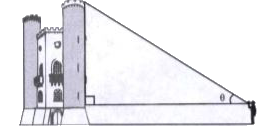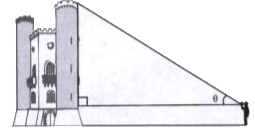Suppose a girl is stitting on the balocny of her house located on the bank of river. She is looking down at a flower pot placed on a stair of a temple situated nearly on other bank of the river. A right triangle is imagined to be made in this situation as shown in figure.

Value of sin 60∘ is …….
1√2
1
0
√32
The correct Answer is:D
Step by step video & image solution for Suppose a girl is stitting on the balocny of her house located on the bank of river. She is looking down at a flower pot placed on a stair of a temple situated nearly on other bank of the river. A right triangle is imagined to be made in this situation as shown in figure. Value of sin 60^(@) is "……." by Maths experts to help you in doubts & scoring excellent marks in Class 10 exams.
Updated on:21/07/2023Topper's Solved these Questions
- INTRODUCTION TO TRIGONOMETRY AND TRIGONOMETRIC IDENTITIES BOOK - OSWAL PUBLICATIONCHAPTER - INTRODUCTION TO TRIGONOMETRY AND TRIGONOMETRIC IDENTITIES EXERCISE - CASE BASED MCQs III
5 Videos
- INTRODUCTION TO TRIGONOMETRY AND TRIGONOMETRIC IDENTITIES BOOK - OSWAL PUBLICATIONCHAPTER - INTRODUCTION TO TRIGONOMETRY AND TRIGONOMETRIC IDENTITIES EXERCISE - Example
2 Videos
- INTRODUCTION TO TRIGONOMETRY AND TRIGONOMETRIC IDENTITIES BOOK - OSWAL PUBLICATIONCHAPTER - INTRODUCTION TO TRIGONOMETRY AND TRIGONOMETRIC IDENTITIES EXERCISE - CASE BASED MCQs I
5 Videos
- INTRODUCTION TO TRIGONOMETRY BOOK - OSWAL PUBLICATIONCHAPTER - INTRODUCTION TO TRIGONOMETRY EXERCISE - Self - Assessment
15 Videos
- LINES (IN TWO - DIMENSIONS)BOOK - OSWAL PUBLICATIONCHAPTER - LINES (IN TWO - DIMENSIONS)EXERCISE - BOARD CORNER (LONG ANSWER TYPE QUESTION)
2 Videos
Similar Questions
Suppose a girl is stitting on the balocny of her house located on the bank of river. She is looking down at a flower pot placed on a stair of a temple situated nearly on other bank of the river. A right triangle is imagined to be made in this situation as shown in figure.
Write the value of sin 30∘

View SolutionSuppose a girl is sitting on the balcony of her house located on the bank of river. She is looking down at a flower pot placed on a stair of a temple situated nearly on other bank of the river. A right triangle is imagined to be made in this situation as shown in figure.

The angle between foot of the building and river is …….. .
View Solution
Knowledge Check
Where is this going? That is the question at the heart of River of Life, River of Death , as author Victor Mallet travels the length of the Ganges. Beginning at its ice cave source in the Himalayan foothills, he follows the water through the hold confluence at Allahabed, the spindly bank of Varanasi city and onwards to the delta in Bangladesh, where "in its parting gift to the land, the river spews millions of tons of fertile silt on to the rice spews millions of tons of fertile silt on the rice fields of Bengal and the mangroves of the Sundarbans. "
It is the same question he asks about the treatment of the Ganges, both good and bad. The river leads a double life, being the most worshipped waterway in the world and also one of the most polluted. The Ganges and its tributaries are now subject to sewage pollution that is "half a million times over the Indian recommended limit for bathing" in places, not to mention the unchecked runoff from heavy metals, fertilizers, carcinogens and the occasional corpse.
As mallet observes, the danger of contamination does not put off the millions of revelers at Kumbh Mela. It is a Hindu pilgrimage "thought to be the largest gathering of people anywhere", described to him as "a spiritual expo where you will be talking one moment to a visiting Mumbai businessman and the next to a marijuana- stoned yogi". He suggests the pollution might never deter them. He is told by one bather. "we do believe that anyone who takes in this water, he becomes pure also, because it is always pure." There is a collective sense that the spirit of the Ganges is so sacred that she can never be spoiled.
He informs the reader in the preface - "almost everyone knows the problems are real," His journey down the Ganges is one of investigation rather than discovery. Mallet investigates the potential of the river to become a cradle for antibiotic resistant infections - or. superbugs. that could be exported to other regions by global travel. He points out that some 450 million people depend on the Ganges water basin for survival, and many more for its religious and cultural importance. The Ganges is a goddess and a mother to everyone from the politician in the north, to the humblest Hindu living in the far south or running a motel in the United States.
There is hope, Mallet draws some parallels to clean - ups of the Rhine and the Thames. He points to the design feat of Kumbh Mela, which as .a pop - up megacity. for two million pilgrims has better infrastructure and waste treatment than many Indian cities. "In the minds of both Indians and foreigners, this raises important questions if the authorities can build infrastructure so efficiently for this short but very large festival, why can they not do the same for permanent villages and towns ?"
Which one of the options fills in the blank and completes the statement below correctly ?
The Ganges is a mother to the devout Hindu, however, it is to the non-Hindu Indian . . . . and . . . .Aa spectacle, locus for the Khumb MelasBa source of water, a garbage binCan interesting tourist spot, a zone for adventure sportsDa cultural icon, provider of lifeWhere is this going? That is the question at the heart of River of Life, River of Death , as author Victor Mallet travels the length of the Ganges. Beginning at its ice cave source in the Himalayan foothills, he follows the water through the hold confluence at Allahabed, the spindly bank of Varanasi city and onwards to the delta in Bangladesh, where "in its parting gift to the land, the river spews millions of tons of fertile silt on to the rice spews millions of tons of fertile silt on the rice fields of Bengal and the mangroves of the Sundarbans. "
It is the same question he asks about the treatment of the Ganges, both good and bad. The river leads a double life, being the most worshipped waterway in the world and also one of the most polluted. The Ganges and its tributaries are now subject to sewage pollution that is "half a million times over the Indian recommended limit for bathing" in places, not to mention the unchecked runoff from heavy metals, fertilizers, carcinogens and the occasional corpse.
As mallet observes, the danger of contamination does not put off the millions of revelers at Kumbh Mela. It is a Hindu pilgrimage "thought to be the largest gathering of people anywhere", described to him as "a spiritual expo where you will be talking one moment to a visiting Mumbai businessman and the next to a marijuana- stoned yogi". He suggests the pollution might never deter them. He is told by one bather. "we do believe that anyone who takes in this water, he becomes pure also, because it is always pure." There is a collective sense that the spirit of the Ganges is so sacred that she can never be spoiled.
He informs the reader in the preface - "almost everyone knows the problems are real," His journey down the Ganges is one of investigation rather than discovery. Mallet investigates the potential of the river to become a cradle for antibiotic resistant infections - or. superbugs. that could be exported to other regions by global travel. He points out that some 450 million people depend on the Ganges water basin for survival, and many more for its religious and cultural importance. The Ganges is a goddess and a mother to everyone from the politician in the north, to the humblest Hindu living in the far south or running a motel in the United States.
There is hope, Mallet draws some parallels to clean - ups of the Rhine and the Thames. He points to the design feat of Kumbh Mela, which as .a pop - up megacity. for two million pilgrims has better infrastructure and waste treatment than many Indian cities. "In the minds of both Indians and foreigners, this raises important questions if the authorities can build infrastructure so efficiently for this short but very large festival, why can they not do the same for permanent villages and towns ?"
Which one of the statements below is false?AVictor Mallet asks the questions .where is it going?. of the river Ganges which has a metaphorical relevance tooBA clean River Ganges is as feasible as a clean River Thames or River RhineCThe Ganges carries superbugs and it is a problem all Indian are aware ofDThe Kumbh Mela is a witness not only to the devotion of a section of Indians but also their skills of crowd management.Where is this going? That is the question at the heart of River of Life, River of Death , as author Victor Mallet travels the length of the Ganges. Beginning at its ice cave source in the Himalayan foothills, he follows the water through the hold confluence at Allahabed, the spindly bank of Varanasi city and onwards to the delta in Bangladesh, where "in its parting gift to the land, the river spews millions of tons of fertile silt on to the rice spews millions of tons of fertile silt on the rice fields of Bengal and the mangroves of the Sundarbans. "
It is the same question he asks about the treatment of the Ganges, both good and bad. The river leads a double life, being the most worshipped waterway in the world and also one of the most polluted. The Ganges and its tributaries are now subject to sewage pollution that is "half a million times over the Indian recommended limit for bathing" in places, not to mention the unchecked runoff from heavy metals, fertilizers, carcinogens and the occasional corpse.
As mallet observes, the danger of contamination does not put off the millions of revelers at Kumbh Mela. It is a Hindu pilgrimage "thought to be the largest gathering of people anywhere", described to him as "a spiritual expo where you will be talking one moment to a visiting Mumbai businessman and the next to a marijuana- stoned yogi". He suggests the pollution might never deter them. He is told by one bather. "we do believe that anyone who takes in this water, he becomes pure also, because it is always pure." There is a collective sense that the spirit of the Ganges is so sacred that she can never be spoiled.
He informs the reader in the preface - "almost everyone knows the problems are real," His journey down the Ganges is one of investigation rather than discovery. Mallet investigates the potential of the river to become a cradle for antibiotic resistant infections - or. superbugs. that could be exported to other regions by global travel. He points out that some 450 million people depend on the Ganges water basin for survival, and many more for its religious and cultural importance. The Ganges is a goddess and a mother to everyone from the politician in the north, to the humblest Hindu living in the far south or running a motel in the United States.
There is hope, Mallet draws some parallels to clean - ups of the Rhine and the Thames. He points to the design feat of Kumbh Mela, which as .a pop - up megacity. for two million pilgrims has better infrastructure and waste treatment than many Indian cities. "In the minds of both Indians and foreigners, this raises important questions if the authorities can build infrastructure so efficiently for this short but very large festival, why can they not do the same for permanent villages and towns ?"
Which one of the options fills in the blank and completes the statement below correctly ?
The average believer is of the faith-driven conviction that the river Ganges. . . . . .Ashall never be the object of an investigationBmay never die due to pollutionCwill never infect the believerDcan never be spoiled
Suppose a girl is sitting on the balcony of her house located on the bank of river. She is looking down at a flower pot placed on a stair of a temple situated nearly on other bank of the river. A right triangle is imagined to be made in this situation as shown in figure.

If height of her house is 12 m , and the distance between her house and the river is 5 m , then what will be value of sinθ ?
View SolutionSuppose a girl is sitting on the balcony of her house located on the bank of river. She is looking down at a flower pot placed on a stair of a temple situated nearly on other bank of the river. A right triangle is imagined to be made in this situation as shown in figure.

If width of the river is 15 m , and angle of depression of flower pot from balcony is 60∘ , then what will be height of the building ?
View SolutionWhere is this going? That is the question at the heart of River of Life, River of Death , as author Victor Mallet travels the length of the Ganges. Beginning at its ice cave source in the Himalayan foothills, he follows the water through the hold confluence at Allahabed, the spindly bank of Varanasi city and onwards to the delta in Bangladesh, where "in its parting gift to the land, the river spews millions of tons of fertile silt on to the rice spews millions of tons of fertile silt on the rice fields of Bengal and the mangroves of the Sundarbans. "
It is the same question he asks about the treatment of the Ganges, both good and bad. The river leads a double life, being the most worshipped waterway in the world and also one of the most polluted. The Ganges and its tributaries are now subject to sewage pollution that is "half a million times over the Indian recommended limit for bathing" in places, not to mention the unchecked runoff from heavy metals, fertilizers, carcinogens and the occasional corpse.
As mallet observes, the danger of contamination does not put off the millions of revelers at Kumbh Mela. It is a Hindu pilgrimage "thought to be the largest gathering of people anywhere", described to him as "a spiritual expo where you will be talking one moment to a visiting Mumbai businessman and the next to a marijuana- stoned yogi". He suggests the pollution might never deter them. He is told by one bather. "we do believe that anyone who takes in this water, he becomes pure also, because it is always pure." There is a collective sense that the spirit of the Ganges is so sacred that she can never be spoiled.
He informs the reader in the preface - "almost everyone knows the problems are real," His journey down the Ganges is one of investigation rather than discovery. Mallet investigates the potential of the river to become a cradle for antibiotic resistant infections - or. superbugs. that could be exported to other regions by global travel. He points out that some 450 million people depend on the Ganges water basin for survival, and many more for its religious and cultural importance. The Ganges is a goddess and a mother to everyone from the politician in the north, to the humblest Hindu living in the far south or running a motel in the United States.
There is hope, Mallet draws some parallels to clean - ups of the Rhine and the Thames. He points to the design feat of Kumbh Mela, which as .a pop - up megacity. for two million pilgrims has better infrastructure and waste treatment than many Indian cities. "In the minds of both Indians and foreigners, this raises important questions if the authorities can build infrastructure so efficiently for this short but very large festival, why can they not do the same for permanent villages and towns ?"
Which one of the options faithfully sums up the main ideas on the passage ?
View SolutionWhere is this going? That is the question at the heart of River of Life, River of Death , as author Victor Mallet travels the length of the Ganges. Beginning at its ice cave source in the Himalayan foothills, he follows the water through the hold confluence at Allahabed, the spindly bank of Varanasi city and onwards to the delta in Bangladesh, where "in its parting gift to the land, the river spews millions of tons of fertile silt on to the rice spews millions of tons of fertile silt on the rice fields of Bengal and the mangroves of the Sundarbans. "
It is the same question he asks about the treatment of the Ganges, both good and bad. The river leads a double life, being the most worshipped waterway in the world and also one of the most polluted. The Ganges and its tributaries are now subject to sewage pollution that is "half a million times over the Indian recommended limit for bathing" in places, not to mention the unchecked runoff from heavy metals, fertilizers, carcinogens and the occasional corpse.
As mallet observes, the danger of contamination does not put off the millions of revelers at Kumbh Mela. It is a Hindu pilgrimage "thought to be the largest gathering of people anywhere", described to him as "a spiritual expo where you will be talking one moment to a visiting Mumbai businessman and the next to a marijuana- stoned yogi". He suggests the pollution might never deter them. He is told by one bather. "we do believe that anyone who takes in this water, he becomes pure also, because it is always pure." There is a collective sense that the spirit of the Ganges is so sacred that she can never be spoiled.
He informs the reader in the preface - "almost everyone knows the problems are real," His journey down the Ganges is one of investigation rather than discovery. Mallet investigates the potential of the river to become a cradle for antibiotic resistant infections - or. superbugs. that could be exported to other regions by global travel. He points out that some 450 million people depend on the Ganges water basin for survival, and many more for its religious and cultural importance. The Ganges is a goddess and a mother to everyone from the politician in the north, to the humblest Hindu living in the far south or running a motel in the United States.
There is hope, Mallet draws some parallels to clean - ups of the Rhine and the Thames. He points to the design feat of Kumbh Mela, which as .a pop - up megacity. for two million pilgrims has better infrastructure and waste treatment than many Indian cities. "In the minds of both Indians and foreigners, this raises important questions if the authorities can build infrastructure so efficiently for this short but very large festival, why can they not do the same for permanent villages and towns ?"
Which one of the options fills in the blank and completes the statement below correctly ?
The river Ganges is "the most worshipped waterway in the world and also one of the most polluted. " This brings to light , in reality . . . . . .
View SolutionFor more than three years, Anna Feng didn't tell her husband that she had sunk nearly half of their savings into the Shanghai stock market. While he thought all their money was safely sitting in a bank, the value of the stocks plunged by almost 75%.
But over the past couple of months, the Shanghai market has shown signs of life, and Feng, a 56-year-old retiree, has recouped half her losses. She's quietly hopeful that may be she'll make it all back. "Everyone seems to be so optimistic about the markets now," she says.
Around the world, stocks have been on a tear. In Asia, for example, the Tokyo TOPIX stock index hit a 14-year high last week as a bull run in once-dormant Japan gathered momentum, Mumbai 's main equity index hit an all-time high in trading early Friday amid India's continuing economic boom, and Hong Kong shares reached a five-year high while indices in Singapore, Jakarta and Sydney set new records. And though stoed in Asia, in particular, are on fire, they are not alone. From Germany to Venezuela to South Africa, equity markets in both mature and emerging markets have moved up sharply this year- and show little sign of slowing.
The underpinning for stocks' strong performance, global bulls say, is straight-forward. Economic growth continues to be strong in places where it has been buoyant for several years (the U.S., China and India) and is finally picking up in places where it had been notably absent- Japan and parts of "old" Europe. Moreover, earning and corporate balance sheets around the world are as healthy as they have been in years. ln Japan, corporate profits have climbed for four straight years and consumer spe nding is rising briskly on the back of declining unempement. Economists say that Japan is now in a golden cycle. So, for now, is much of the world. "It comes down to very simple macroeconomics." says Subir Gokam, an economist at CRlSIL, India's largest credit-rating firm. "The global economy is growing without much inflationary pressure."
Is anything wrong with this picture? One very big thing, warn the skeptics. Interest rates are rising nearly everywhere, and if there is one simple adage that many investment advisers live by, It's this: "When rates are high, stocks will die." Indeed, one of the most impressive-or scariest-aspects of the current global bull run is that it has come in the teeth of central- b~nk tightening, most importantly by the U.S. Federal Reserve, which could slow growth in the world's key economic locomotive. The Fed has increased key short-term interest rate-the so-called Fed funds rate-15 times dating back to June 2004, and is widely expected to raise it one or twice more over the next few months. A . briefrecession and the Sept. 11 terrorist attacks in 2001 spuned a prolonged period of very low interst rates. That boosted tJ.S. consumption-in particular the ratesensitive housing market- and kept the global economy humming. But long-term rates are now beginning to tick upward: last week the U.S. 30-year treasury bond reached 5.04% its highest level since late 2004, and the housing market is cooling off-potentially triggering an economic slowdown as homeowners cut their spending.
Which of the following statements is/are FALSE in the context of the passage ?
(A) Economic growth in US, China, India, Japan and old European countries started to show a downward trend.
(B) Higher interest rates help boost stock value
(C) Skeptics firmly believe that economic growth is a boon from all the angles.
View Solution
